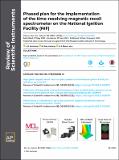Phased plan for the implementation of the time-resolving magnetic recoil spectrometer on the National Ignition Facility (NIF)
Author(s)
Kunimune, JH; Gatu Johnson, M; Moore, AS; Trosseille, CA; Johnson, TM; Berg, GPA; Mackinnon, AJ; Kilkenny, JD; Frenje, JA; ... Show more Show less
DownloadPublished version (4.668Mb)
Publisher with Creative Commons License
Publisher with Creative Commons License
Creative Commons Attribution
Terms of use
Metadata
Show full item recordAbstract
<jats:p> The time-resolving magnetic recoil spectrometer (MRSt) is a transformative diagnostic that will be used to measure the time-resolved neutron spectrum from an inertial confinement fusion implosion at the National Ignition Facility (NIF). It uses a CD foil on the outside of the hohlraum to convert fusion neutrons to recoil deuterons. An ion-optical system positioned outside the NIF target chamber energy-disperses and focuses forward-scattered deuterons. A pulse-dilation drift tube (PDDT) subsequently dilates, un-skews, and detects the signal. While the foil and ion-optical system have been designed, the PDDT requires more development before it can be implemented. Therefore, a phased plan is presented that first uses the foil and ion-optical systems with detectors that can be implemented immediately—namely CR-39 and hDISC streak cameras. These detectors will allow the MRSt to be commissioned in an intermediate stage and begin collecting data on a reduced timescale, while the PDDT is developed in parallel. A CR-39 detector will be used in phase 1 for the measurement of the time-integrated neutron spectra with excellent energy-resolution, necessary for the energy calibration of the system. Streak cameras will be used in phase 2 for measurement of the time-resolved spectrum with limited spectral coverage, which is sufficient to diagnose the time-resolved ion temperature. Simulations are presented that predict the performance of the streak camera detector, indicating that it will achieve excellent burn history measurements at current yields, and good time-resolved ion-temperature measurements at yields above 3 × 10<jats:sup>17</jats:sup>. The PDDT will be used for optimal efficiency and resolution in phase 3. </jats:p>
Date issued
2022-08-01Department
Massachusetts Institute of Technology. Plasma Science and Fusion CenterJournal
Review of Scientific Instruments
Publisher
AIP Publishing
Citation
Kunimune, JH, Gatu Johnson, M, Moore, AS, Trosseille, CA, Johnson, TM et al. 2022. "Phased plan for the implementation of the time-resolving magnetic recoil spectrometer on the National Ignition Facility (NIF)." Review of Scientific Instruments, 93 (8).
Version: Final published version